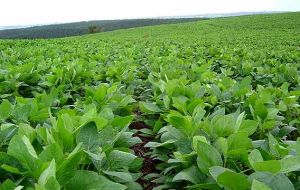MercoPress. South Atlantic News Agency
Too much rainfall threatening Argentina’s record soybean crop
 Last year because of the drought the soy crop was down to 32 million tons and this year down it’s too much water.
Last year because of the drought the soy crop was down to 32 million tons and this year down it’s too much water. Argentina’s record soybean crop may yield less than expected as continued downpours threaten to cause beans to rot and fungal diseases to spread, according to a Buenos Aires Cereals Exchange official quoted on Monday.
Soil may be too humid in major producing areas for harvesters to start operating this week, while fungi that harm plants may spread and pare yields if rains continue, said Eduardo Anchubidart, who heads the Exchange’s crop-forecast division.
“If it continues to rain, it will be difficult for farmers to harvest, and if it doesn’t stop raining, fungal diseases, which affect pods, may spread to the beans and could lower yields.” Argentina’s yields are an estimated 3.5 to 4 tons per hectare.
Argentina, the largest soybean producer after the US and Brazil, is forecasted to produce a record crop this year after abundant rain boosted yields. However downpours have saturated the soil and could lead to fungal disease and rotting of beans, which would then conspire against the estimated 2010 crop of more than 52 million metric tons, said Anchubidart.
The US Department of Agriculture forecasts Argentina’s crop to rise to 53 million tons from a drought-hit 32 million in 2009.
As much as 100 millimeters of rain fell in parts of the area between Feb. 18 and 21, according to estimates by the Rosario Cereals Exchange.
“The heart of the Soy-Belt has enough water, and certain parts, mainly those on the eastern sides, already have too much water,” Anchubidart said. “This was a peculiar season for planting, because there was a lot of rain in October and November and this led to delays in planting in some regions”.
About a third of Argentina’s 19 million hectares of soy crops are located in the so-called Soybean Belt, where the El Nino meteorological phenomenon has triggered above-average rainfall. Harvesting in the area, which has the highest yields in the country, is scheduled to start this week and continue through March.




Top Comments
Disclaimer & comment rulesCommenting for this story is now closed.
If you have a Facebook account, become a fan and comment on our Facebook Page!